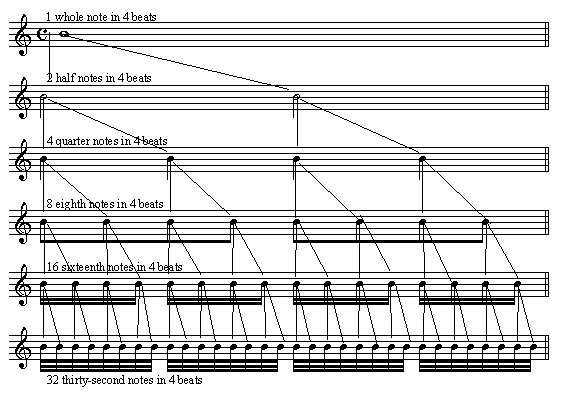All you ever wanted to know about sheet music and how to read it.
Introduction: There are two basic aspects of reading music. First, rhythms- how the notes of the melody fit within time, and second, pitch- how high or low these rhythmic notes are. The first part of this tutorial will cover rhythms.
Understanding the Basics of Counting Rhythms
The first step in understanding rhythms is to memorize the various notes and their 'values.' You don't need to understand them now, but for information's sake, look over the five most commonly used notes:
|
|
four beats long |
| two beats long | |
| one beat long | |
| half a beat long | |
| quarter of a beat. |
It's confusing to think of something being an eighth of a beat, and you may wonder why a note that is one beat long is called a quarter note. Why wouldn't it be called a whole note, since it's a whole beat?
It's because we name our notes based on the length of time they are played within a measure, not based on how many beats they are.
![]()
I often tell my students to think of a measure as a whole pie, in that it can be cut into quarters (4 pieces), eighths (8 pieces), and so on. A whole note is called a whole notebecause it is played and held for a whole measure. A quarter note is called aquarter note because a full quarter note takes up exactly one quarter of a measure.
I know what you're saying. "Yuck! Fractions!" To this, I hang my head sadly and nod. You're absolutely right. But I'm not going to make you add fractions, or anything like that. If you get the pie illustration, then you're set.
Now that we understand why the notes are named the way they are, let's look at the chart again:
|
|
Fills a whole measure |
| played for half a measure | |
| one quarter of a measure | |
| eighth of a measure | |
| sixteenth of a measure |
Dividing a measure up into eighths and sixteenths on the fly while playing would be difficult, especially with complicated rhythms, so this is useful mostly as an understanding of the basics. The next step to take is to actually count through the rhythms.
Counting Through The Rhythms
As evenly as you can, count to 4 like this: 1- 2 - 3 - 4, 1 - 2 - 3 - 4. Repeat the counting over and over again. Try to make sure each number is evenly spaced. Don't count like this: 1... 2... 3 4... or any other jilted time. It doesn't matter how fast you count, but keep the numbers evenly spaced.
You are counting 4 beats in a measure, so each number is the value of a quarter note! Congratulations!
Now, while counting, clap your hands only when you say "1." Hold your hands together to simulate holding the note until you have said 4, then clap again on 1. You are now "playing" a whole note!
FYI: We're going to use hand claps as our "instrument." If you're in a place where it's conspicuous to clap your hands, then tap a toe or a finger tip.
Now clap on each count. You are "playing" quarter notes.
Continue to count 1234, but clap an extra time between each count. It might help to say "1 and 2 and 3 and 4 and" so you stay even. Once you get this down you are clapping eighths! You've divided the pie into eight even pieces!
Study the diagram below: Notice that the eighth notes on the fourth line (called a staff in music) look a little different than this
![]() . Their flags are joined together! This simply
makes for easier reading. The same is true for any other note with a flag.
. Their flags are joined together! This simply
makes for easier reading. The same is true for any other note with a flag.

In our counting exercise we skipped clapping on the half beats, on the sixteenth beats, and on the thirty-second beats. As a personal challenge, see if you can master this on your own. Have fun with the thirty-seconds! They're fast!
Counting Rhythms
Time Signatures
Reading Exercises
Reading Syncopation
Accents and Markings
Basics of Pitches
Intervals
Flats & Sharps
Key Signatures
Clefs & Staves
DS, DC, & Repeat Signs
How to Transpose Music
The Circle of Fifhs
Reading Exercises- Tips
Tools
Games
Note Blaster
Piano Key Race
Save the City
Lessons Coming Soon:
Reading Rests
Practicing Effectively